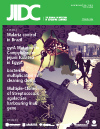Comparison of immunohistochemistry and polymerase chain reaction for detection of West Nile virus in naturally infected dead birds
DOI:
https://doi.org/10.3855/jidc.937Keywords:
Immunohistochemistry, RT-PCR, West Nile virus, vector-borne disease surveillanceAbstract
Introduction: Credible vector-borne disease surveillance programs, especially in developing countries with limited resources, must include diagnostic tests that are efficient, inexpensive and simple and safe to administer while maintaining high levels of sensitivity and specificity. Since immunohistochemistry (IHC) includes most of these features, its sensitivity, specificity, predictive positive value (PPV) and predictive negative value (PNV) for West Nile virus (WNv) screening were compared to those of the gold standard, RT-PCR testing of kidney tissue in dead birds.
Methodology: IHC and RT-PCR were performed for WNv antigen on 41 dead birds (belonging to five orders) collected from the northwest region of the Riverside County of California. Fixed tissue sections were screened by IHC using polyclonal antibodies, and frozen kidney tissues were tested with RT-PCR.
Results: Kidney screening with IHC showed sensitivity, specificity, PPV and NPV of 95.45%, 73.68%, 80.77% and 93.33%, respectively. Based on WNv screening of kidney tissue, IHC and RT-PCR were in agreement with 95.45% (21/22) for positive dead birds and were in 100% (22/22) agreement when multi-organ screening by IHC was performed.
Conclusions: The present study showed that IHC is as equally effective as RT-PCR in screening for WNv in dead birds. Therefore, IHC can effectively serve as a competent screening technique for those disease surveillance agencies that lack expensive RT-PCR technology while promoting safer biohazardous conditions, except at the initial stage of tissue collection.
Downloads
Published
How to Cite
Issue
Section
License
Authors who publish with this journal agree to the following terms:
- Authors retain copyright and grant the journal right of first publication with the work simultaneously licensed under a Creative Commons Attribution License that allows others to share the work with an acknowledgement of the work's authorship and initial publication in this journal.
- Authors are able to enter into separate, additional contractual arrangements for the non-exclusive distribution of the journal's published version of the work (e.g., post it to an institutional repository or publish it in a book), with an acknowledgement of its initial publication in this journal.
- Authors are permitted and encouraged to post their work online (e.g., in institutional repositories or on their website) prior to and during the submission process, as it can lead to productive exchanges, as well as earlier and greater citation of published work (See The Effect of Open Access).








